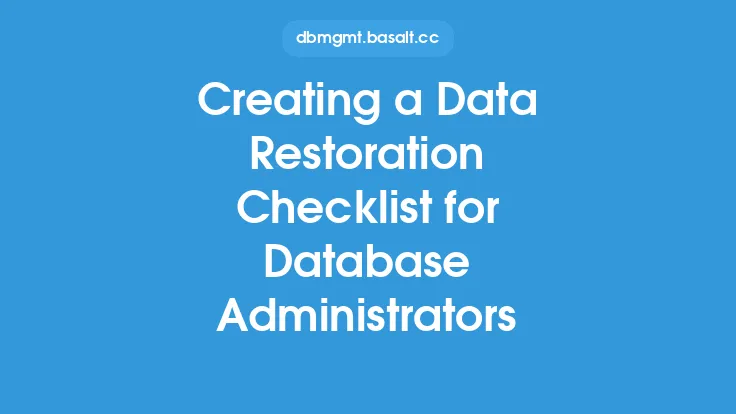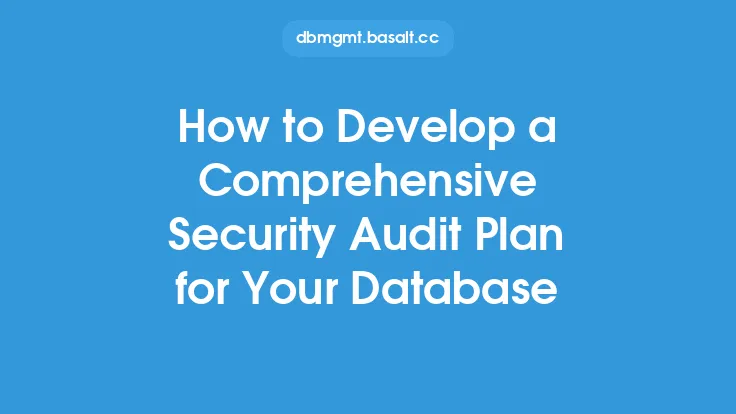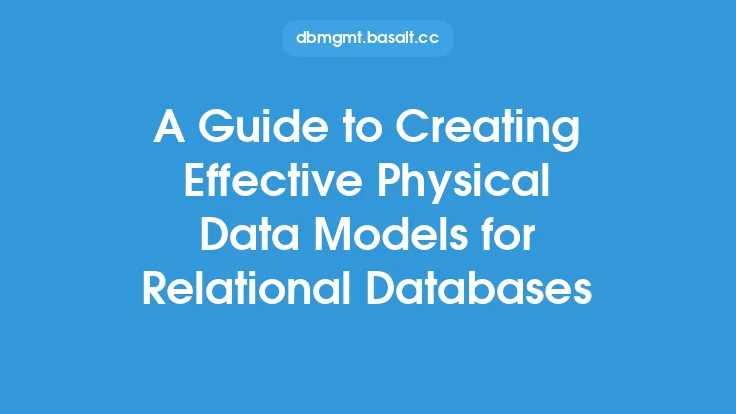Creating a robust data classification system is a crucial aspect of database design, as it enables organizations to manage their data effectively, ensure compliance with regulatory requirements, and protect sensitive information. A well-designed data classification system helps to categorize data based on its sensitivity, importance, and potential impact on the organization, allowing for more efficient data management, storage, and retrieval.
Introduction to Data Classification
Data classification is the process of assigning a level of sensitivity or importance to data based on its content, context, and potential impact on the organization. This process involves identifying, categorizing, and labeling data to ensure that it is handled, stored, and protected accordingly. A data classification system typically consists of a set of categories or levels, each with its own set of access controls, storage requirements, and handling procedures. The primary goal of data classification is to ensure that sensitive data is protected from unauthorized access, theft, or damage, while also ensuring that data is available to authorized personnel when needed.
Benefits of Data Classification
Implementing a data classification system offers several benefits, including:
- Improved data security: By categorizing data based on its sensitivity, organizations can implement targeted security measures to protect sensitive data from unauthorized access or theft.
- Enhanced compliance: Data classification helps organizations comply with regulatory requirements, such as GDPR, HIPAA, and PCI-DSS, by ensuring that sensitive data is handled and stored in accordance with relevant laws and regulations.
- Better data management: Data classification enables organizations to manage their data more effectively, by identifying areas where data is redundant, outdated, or unnecessary, and eliminating or archiving it as needed.
- Increased efficiency: By categorizing data based on its importance and sensitivity, organizations can prioritize data storage, retrieval, and backup, ensuring that critical data is readily available when needed.
Data Classification Categories
A typical data classification system consists of several categories, each with its own set of characteristics and requirements. The most common categories include:
- Public data: This category includes data that is publicly available and can be accessed by anyone, such as marketing materials, press releases, and public websites.
- Internal data: This category includes data that is intended for internal use only, such as employee information, company policies, and internal reports.
- Confidential data: This category includes data that is sensitive and requires restricted access, such as financial information, customer data, and intellectual property.
- Restricted data: This category includes data that is highly sensitive and requires strict access controls, such as personal identifiable information (PII), credit card numbers, and sensitive business information.
- Top-secret data: This category includes data that is extremely sensitive and requires the highest level of access controls, such as national security information, trade secrets, and highly confidential business information.
Data Classification Criteria
When developing a data classification system, organizations should consider several criteria, including:
- Sensitivity: The level of sensitivity or confidentiality of the data, including the potential impact on the organization if the data is compromised.
- Importance: The level of importance or criticality of the data, including its impact on business operations, customer relationships, or regulatory compliance.
- Value: The monetary or intrinsic value of the data, including its potential for reuse, resale, or exploitation.
- Regulatory requirements: The relevant laws, regulations, and industry standards that govern the handling, storage, and protection of the data.
- Access controls: The level of access control required to protect the data, including authentication, authorization, and encryption.
Implementing a Data Classification System
Implementing a data classification system requires a structured approach, including:
- Data discovery: Identifying and cataloging all data assets within the organization, including data stored in databases, files, and applications.
- Data categorization: Assigning a classification category to each data asset, based on its sensitivity, importance, and value.
- Data labeling: Labeling each data asset with its corresponding classification category, to ensure that it is handled and stored accordingly.
- Access controls: Implementing access controls, such as authentication, authorization, and encryption, to protect sensitive data from unauthorized access.
- Training and awareness: Educating employees on the importance of data classification, and the procedures for handling and storing sensitive data.
Technical Implementation
From a technical perspective, implementing a data classification system may involve several components, including:
- Data classification software: Utilizing software tools, such as data classification platforms, to automate the data classification process, and ensure consistency and accuracy.
- Data labeling tools: Using data labeling tools, such as metadata management tools, to label and categorize data assets, and ensure that they are handled and stored accordingly.
- Access control systems: Implementing access control systems, such as identity and access management (IAM) systems, to control access to sensitive data, and ensure that only authorized personnel can access or modify it.
- Encryption technologies: Utilizing encryption technologies, such as symmetric and asymmetric encryption, to protect sensitive data from unauthorized access, and ensure that it is transmitted and stored securely.
Maintenance and Review
A data classification system requires regular maintenance and review to ensure that it remains effective and relevant. This includes:
- Periodic review: Regularly reviewing the data classification system to ensure that it is aligned with changing business needs, regulatory requirements, and technological advancements.
- Updates and revisions: Updating and revising the data classification system as needed, to reflect changes in the organization, its data assets, or the regulatory environment.
- Training and awareness: Continuously educating employees on the importance of data classification, and the procedures for handling and storing sensitive data, to ensure that the system remains effective and relevant.
Conclusion
Creating a data classification system is a critical aspect of database design, as it enables organizations to manage their data effectively, ensure compliance with regulatory requirements, and protect sensitive information. By understanding the benefits, categories, and criteria for data classification, organizations can develop a robust data classification system that meets their unique needs and requirements. Implementing a data classification system requires a structured approach, including data discovery, categorization, labeling, access controls, and training and awareness. Regular maintenance and review are also essential to ensure that the system remains effective and relevant over time.





